Planorbidae
Planorbidae, common name the ramshorn snails or ram's horn snails, is a family of air-breathing freshwater snails, aquatic pulmonate gastropod molluscs. Unlike most molluscs, the blood of ram's horn snails contains iron-based hemoglobin instead of copper-based hemocyanin.[3] As a result, planorbids are able to breathe oxygen more efficiently than other molluscs. The presence of hemoglobin gives the body a reddish colour. This is especially apparent in albino animals.
| Planorbidae | |
|---|---|
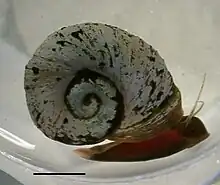 | |
| A live individual of Indoplanorbis exustus | |
| Scientific classification | |
| Domain: | Eukaryota |
| Kingdom: | Animalia |
| Phylum: | Mollusca |
| Class: | Gastropoda |
| Subclass: | Heterobranchia |
| Superorder: | Hygrophila |
| Superfamily: | Lymnaeoidea |
| Family: | Planorbidae Rafinesque, 1815[1] |
| Genera | |
|
See text | |
| Diversity[2] | |
| About 250 freshwater species | |
Being air breathers like other Panpulmonata, planorbids do not have gills, but instead, have a lung. The foot and head of planorbids are rather small, while their thread-like tentacles are relatively long. Many of the species in this family have coiled shells that are planispiral, in other words, the shells are more or less coiled flat, rather than having an elevated spire as is the case in most gastropod shells. Although they carry their shell in a way that makes it appear to be dextral, the shell of coiled planorbids is in fact sinistral in coiling, but is carried upside down, which makes it appear to be dextral.
General taxonomic context
For several taxa, no consensus exists as to whether the taxa should even be assigned to the family Planorbidae. This is certainly the case with the freshwater limpets Ferrissia, and Ancylus. Both of these genera have sometimes been assigned to the family Lymnaeidae. Alternatively, sometimes each one of them is raised to the level of a family. However, according to the taxonomy of the Gastropoda (Bouchet & Rocroi, 2005), these genera are currently placed in the tribe Ancylini within the family Planorbidae, and that is the taxonomic system that is followed here.
2005 taxonomy
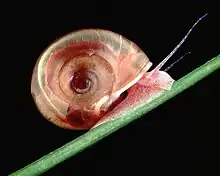
According to the taxonomy of the Gastropoda (Bouchet & Rocroi, 2005), this family consists of the following subfamilies:
- subfamily Planorbinae Rafinesque, 1815
- tribe Planorbini Rafinesque, 1815 - synonyms: Choanomphalinae Fisher & Crosse, 1880; Orygoceratidae Brusina, 1882
- tribe Ancylini Rafinesque, 1815 - synonym: Pseudancylinae Walker, 1923 (inv.)
- tribe Biomphalariini Watson, 1954 - synonyms: Acrorbini Starobogatov, 1958; Drepanothrematini Zilch, 1959; Taphiinae Harry & Hubendick, 1964
- tribe Planorbulini Pilsbry, 1934
- tribe Segmentinini Baker, 1945
- subfamily Bulininae Fischer & Crosse, 1880
- tribe Bulinini Fischer & Crosse, 1880 - synonyms: Laevapicinae Hannibal, 1912; Isidorinae Annandale, 1922; Gundlachiinae Starobogatov, 1967
- tribe Coretini Gray, 1847 - synonyms: Pompholicinae Dall, 1866 (inv.); Camptoceratinae Dall, 1870; Megasystrophinae Tryon, 1871 (inv.); Pompholycodeinae Lindholm, 1927; Helisomatinae Baker, 1928; Bayardellini Starobogatov & Prozorova, 1990; Planorbariini Starobogatov, 1990
- tribe Miratestini Sararsin & Sarasin, 1897 - synonyms: Ferrissiinae Walker, 1917; Ancylastrinae Walker, 1923; Protancylinae Walker, 1923; Physastrinae Starobogatov, 1958; Ameriannini Zilch, 1959; Patelloplanorbidae Franc, 1968
- tribe Plesiophysini Bequaert & Clench, 1939
- subfamily Neoplanorbinae Hannibal, 1912 - synonym: Payettiinae Dall, 1924
- subfamily Rhodacmeinae Walker, 1917
2007 taxonomy for part of the family
Albrecht et al. (2007)[4] analyzed a limited number of genera of Planorbidae, based on sequences of mitochondrial 18S ribosomal DNA and cytochrome-c oxidase I (COI) genes, and on the basis of the results, they rearranged the taxonomy like this:
"A-clade" sensu Albrecht et al. (2007)[4]
- Burnupia Walker, 1912
Tribus Bulinini
- Bulinus Müller, 1781
- Indoplanorbis Annandale, 1921
Tribus Ancylini Rafinesque-Schmaltz, 1815
- Ancylus Müller, 1774
- Ferrissia Walker, 1903
- Gundlachia Pfeiffer, 1849
- Laevapex Walker, 1903
- Hebetancylus Pilsbry, 1914
"B-clade" sensu Albrecht et al., (2007)[4]
- Glyptophysa Crosse, 1872
- Protancylus Sarasin, 1897
- Kessneria Walker & Ponder, 2001
- Leichhardtia Walker, 1988
Tribus Camptoceratini
- Planorbarius Duméril, 1806
Tribus Planorbini
- Anisus Studer, 1820
- Bathyomphalus Charpentier, 1837
- Gyraulus Charpentier, 1837
- Hovorbis Brown & Mandahl-Barth, 1973
- Choanomphalus Gerstfeldt, 1859
- Planorbis Müller, 1774
Tribus Segmentinini
- Segmentina Fleming, 1818
- Hippeutis Charpentier, 1837
- Polypylis Pilsbry, 1906
"C-Clade" sensu Albrecht et al., (2007)[4]
- Biomphalaria Preston, 1910
- Menetus Adams & Adams, 1855
- Planorbella Haldeman, 1843
- Planorbula Haldeman, 1843
Cladogram
The following is a cladogram that shows the phylogenic relationships within the Planorbidae according to Albrecht 2007:[4]
| ||||||||||||||||||||||||||||||||||||||||||||||||||||||||||||||||||||||||||||||||||||||||||||||||||||||||||||||||||||||||||||||||||||||||
Genera
The type genus of this family is Planorbis Müller. The following list of genera is organized according to the 2005 taxonomy, because Albrecht's 2007 taxonomy is not available for all genera of Planorbidae. Genera in the family Planorbidae include (subgenera listed according to Glöer (2002):[5]
- subfamily Planorbinae Rafinesque, 1815
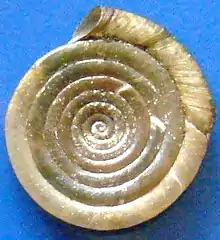
- Anisus S. Studer, 1820
- subgenus Disculifer Boettger, 1944
- Bathyomphalus Charpentier, 1837
- Gyraulus Charpentier, 1837
- subgenus Torquis Dall, 1905
- subgenus Lamorbis Starobogatov, 1967
- subgenus Armiger Hartmann, 1843
- Hippeutis Charpentier, 1837
- Anisus S. Studer, 1820
- tribe Ancylini Rafinesque, 1815
- tribe Biomphalariini Watson, 1954
- Biomphalaria Preston, 1910 - type genus of tribe Biomphalariini[6]
- Drepanotrema Crosse & Fischer, 1880[6]
- tribe Planorbini Rafinesque, 1815
- Afrogyrorbis Starobogatov, 1967[7]
- Planorbis Müller, 1773[6]
- tribe Planorbulini Pilsbry, 1934
- Planorbula Haldeman, 1840 - type genus of tribe Planorbulini[6]
- tribe Segmentinini Baker, 1945
- Segmentina Fleming, 1818 - type genus of tribe Segmentinini[6]
- subfamily Bulininae Fischer & Crosse, 1880
- Indoplanorbis Annandale & Prashad, 1920 - contains one species Indoplanorbis exustus[8]
- Planorbarius Duméril, 1806
- Planorbella Haldeman, 1842
- Menetus Adams & Adams, 1855
- subgenus Dilatata Clessin, 1885
- tribe Bulinini Fischer & Crosse, 1880
- Bulinus Müller, 1781 - type genus of subfamily Bulininae[6]
- Gundlachia Pfeiffer, 1849
- tribe Coretini Gray, 1847
- Coretus Gray, 1847 - type genus of tribe Coretini[6]
- tribe Miratestini Sarasin & Sarasin, 1897
- tribe Plesiophysini Bequaert & Clench, 1939
- Plesiophysa Fischer, 1883 - type genus of tribe Plesiophysini[6]
- subfamily Neoplanorbinae Hannibal, 1912
- Neoplanorbis Pilsbry, 1906 - type genus of subfamily Neoplanorbinae[6]
- subfamily Rhodacmeinae Walker, 1917
Subfamily = ? (other genera that are not yet sorted are listed here)
- Acrorbis Odhner, 1937
- Africanogyrus Özdikmen & Darilmaz, 2007
- synonym: Afrogyrus Brown & Mandahl-Barth, 1973 - Afroplanorbis Thiele, 1931
- Amphigyra Pilsbry, 1906
- Anisopsis Sandberger, 1875
- Antillorbis Harry & Hubendick, 1964
- Armigerus Clessin, 1884
- Australorbis Pilsbry, 1934
- Bayardella Burch, 1977
- Berellaia Laubrière & Carez, 1880
- Camptoceras Benson, 1843
- Camptoceratops Wenz, 1923
- Carinifex Binney, 1865
- Carinogyraulis Polinski, 1929
- Ceratophallus Brown & Mandahl-Barth, 1973
- Choanomphalus Gerstfeldt, 1859
- Culmenella Clench, 1927[9]
- Fossulorbis Pilsbry, 1934
- Glyptophysa Crosse, 1872
- Helicorbis Benson, 1855
- Helisoma Swainson, 1840
- Intha Annandale, 1922
- Isidorella Tate, 1896
- Kessneria Walker & Ponder, 2001
- Leichhardtia Walker, 1988
- Lentorbis Mandahl-Barth, 1954
- Macrophysa (Meek) Dall, 1870
- Paraplanorbis Hanna, 1922
- Patelloplanorbis Hubendick, 1957
- Pecosorbis Taylor, 1985
- Pentagoniostoma Branson, 1935
- Perrinilla Hannibal, 1912
- Physastra Tapparone-Canefri, 1883
- Physopsis Krauss, 1848
- Pingiella Baker, 1945
- Pitharella Edwards, 1860
- Planorbifex Pilsbry, 1935
- Planorbina Haldeman, 1842
- Platyphysa Fischer, 1883
- Platytaphius Pilsbry, 1924
- Polypylis Pilsbry, 1906
- Promenetus Baker, 1935
- Protancylus Sarasin & Sarasin, 1897
- Pygmanisus Iredale, 1943
- Segmentorbis Mandahl-Barth, 1954
- Sineancylus Gutiérrez Gregoric, 2014
- Syrioplanorbis Baker, 1945
- Trochorbis Benson, 1855
- Vorticifex Meek in Dall, 1870
The genus Camptoceratops Wenz, 1923 is no longer considered to be a planorbid. It was recognised by Curry (1965, p. 360) as a euthecosomatous pteropod (Heterobranchia) (note by Arie W. Janssen, 092507).
The generic name Taphius Adams & Adams, 1855 is a synonym for Biomphalaria.[6]
Shell description
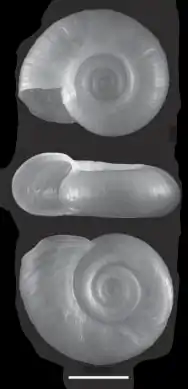
The shells of most species in this family are disk-like or button-like, being coiled in one plane, although several groups have shells that are more higher-spired, and some are limpet-like.
All coiled shell Planorbidae are sinistral in their shell coiling, as is proved by their internal anatomy (the respiratory and the genital orifice are situated on the left side), however the animals carry their shells with what would normally be the ventral (i.e. umbilical) surface uppermost, and because of this, the shells appear to be dextral.
Indeed, formerly planorbids were thought to have dextral shells, and so species of this family were figured as if they had dextral shells. Although it is now understood that these species are sinistral in shell coiling, disk-like Planorbid shells are often still shown in illustrations oriented as if they were dextral.
Most species of coiled planorbids have a rather thin and moderately smooth shell, although more distinct sculpture such as a keel occurs in, and is diagnostic of, certain species. In the flat, keeled species, the whorls tend to overlap.
The aperture has a sharp outer lip. A peristome can be present, but often the lip is not thickened nor reflected. Those planorbid species which have a high-spired shell may have a narrow umbilicus, but frequently this is covered by callus.
In height most species vary between 6 mm and 6 cm, however, disk-like shells are usually less than about 2 cm in maximum dimension.
Like all pulmonate aquatic snails, ramshorn shells do not have an operculum to close the shell aperture.
Sinistral shells
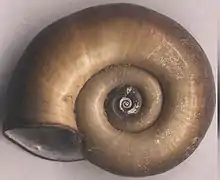
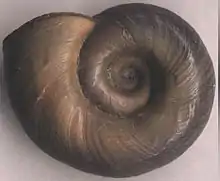
Flat-coiled planorbid gastropod shells are hard to understand in terms of their coiling and orientation. Many of the shells of species in this family are almost planispiral in coiling such that one side of the shell often looks rather like the other side, but it is important to bear in mind that nonetheless there is an umbilical side and a spire side of the shell. In addition these are in fact sinistral shells, despite the fact that the snail carries its shell as if it were a normal dextral shell. To make sense of the shell coiling, the following facts are useful:
- In life, these pond snails hold their shells upside down compared to the normal gastropod shell orientation, with the umbilicus facing upwards.
- The spire of the shell is quite sunken in many species. In addition, it is carried facing downwards.
- The umbilicus of the shell is very wide and shallow.
- In some species the umbilicus is not as deeply "dished" as the sunken spire is, so superficially it can be hard to tell one from the other.
However, once it is understood that the planorbid shell is sinistral, if the shell is held with the aperture on the left and facing the observer, then the sunken spire side of the shell is uppermost. This is a convenience for understanding the shell, but is the opposite of the way the shell is actually carried in life.
The side of the shell which is in fact the spire (a sunken spire) faces down in the living animal, contrary to what is the case in almost all other shelled gastropods. Because the shell is carried "upside down" like this, the aperture of the shell is angled to face downwards also, so the aperture faces a little towards the spire, not away from it, as is usually the case in other shelled gastropods.
Habitat
Most species of planorbids live only in fresh water, such as ponds, lakes, and slow moving rivers. A minority of species are able to survive in brackish water.
Geological history
Ancestors of ramshorn snails are known with certainty since the Jurassic period. Modern taxa developed in the Jurassic.
Geographical distribution
Species in this family occur worldwide. In Northwest Europe about 20 species are known (including non-indigenous species). In this region, various extinct taxa are known to have occurred, starting in the Jurassic period.
References
- Rafinesque C. S. 1815. Analyse de la Nature ou tableau de l'univers et des corps organisés. Palermo, 223 pp., page 143.
- Strong E. E., Gargominy O., Ponder W. F. & Bouchet P. (2008). "Global Diversity of Gastropods (Gastropoda; Mollusca) in Freshwater". Hydrobiologia 595: 149-166. hdl:10088/7390 doi:10.1007/s10750-007-9012-6.
- Lieb, Bernhard; et al. (8 August 2006). "Red blood with blue-blood ancestry: Intriguing structure of a snail hemoglobin". Proceedings of the National Academy of Sciences of the United States of America. 103 (32): 12011–12016. Bibcode:2006PNAS..10312011L. doi:10.1073/pnas.0601861103. PMC 1567689. PMID 16877545.
We present here the complete cDNA and predicted amino acid sequence of two hemoglobin polypeptides from the planorbid Biomphalaria glabrata...Moreover, we identified a previously undescribed rosette-like hemolymph protein that has been mistaken for hemoglobin. We also detected expression of an incomplete hemocyanin as trace component. The combined data show that B. glabrata hemoglobin evolved from pulmonate myoglobin, possibly to replace a less-efficient hemocyanin, and reveals a surprisingly simple evolutionary mechanism to create a high molecular mass respiratory protein from 78 similar globin domains.
- Albrecht C., Kuhn K. & Streit B. (2007). "A molecular phylogeny of Planorboidea (Gastropoda, Pulmonata): insights from enhanced taxon sampling". Zoologica Scripta 36: 27-39.doi:10.1111/j.1463-6409.2006.00258.x.
- (in German) Glöer P. 2002. Die Süßwassergastropoden Nord- und Mitteleuropas. Die Tierwelt Deutschlands, ConchBooks, Hackenheim, 326 pp., ISBN 3-925919-60-0, page 19-20.
- Bouchet, Philippe; Rocroi, Jean-Pierre; Frýda, Jiri; Hausdorf, Bernard; Ponder, Winston; Valdés, Ángel & Warén, Anders (2005). "Classification and nomenclator of gastropod families". Malacologia. Hackenheim, Germany: ConchBooks. 47 (1–2): 1–397. ISBN 3-925919-72-4. ISSN 0076-2997.
- Starobogatov, Y. I. (1967). On the systematization of freshwater pulmonate molluscs. Trudy Zoologicheskogo Instituta, Leningrad, 42, 280–304.
- Liu L et al. (2010) "The phylogeography of Indoplanorbis exustus (Gastropoda: Planorbidae) in Asia". Parasites & Vectors 3: 57. doi:10.1186/1756-3305-3-57.
- Mollusc Specialist Group (1996). Culmenella rezvoji. In: IUCN 2010. IUCN Red List of Threatened Species. Version 2010.4. <www.iucnredlist.org>. Downloaded on 08 March 2011.
- (in Dutch) Gittenberger, E., Janssen, A.W., Kuijper, W.J., Kuiper, J.G.J., Meijer, T., Velde, G. van der & Vries, J.N. de (1998) De Nederlandse zoetwatermollusken. Recente en fossiele weekdieren uit zoet en brak water Nederlandse Fauna 2. Nationaal Natuurhistorisch Museum Naturalis, KNNV Uitgeverij & EIS-Nederland, Leiden, 288 pp.
- (in French) Fischer, P.H. (1880-1887) Manuel de Conchyliologie et de Paléontologie conchyliologique ou histoire naturelle des Mollusques vivants et fossiles suivi d'un appendice sur les Brachiopodes par D. Oehlert. – XXIV + 1369 pp.
- (German) Thiele, J. (1929-1935) Handbuch der Systematischen Weichtierkunde. Jena, (1), 1–376, 1929; (2), 377–778, 1931; 779–1022, 1934; 1023–1134, 1935.
- (in English) Vaught, K.C. (1989) A classification of living mollusca. American Malacologists Inc., Melbourne USA, ISBN 0-915826-22-4 & 0-915826-22-6, 195 pp.
- (German) Wenz, W. (1923-1930) Gastropoda extramarina tertiaria. Fossilium Catalogus I. (4 vols.), 3387 pp.
- (German) Zilch, A. (1959-1960) Euthyneura. In: H. Schindewolf (ed.), Handbuch der Paläozoologie, 6(2): pp. I-XII + 1–834.
External links
- (in English) NCBI Taxonomy Browser: Planorbidae
- (in English) Systema naturae 2000 (classification) - Taxon: Planorbidae
- (in English) ITIS: Planorbidae
- (in English) http://mkohl1.net/Planorbidae.html
- Frank Collins Baker, The Molluscan Family Planorbidae, The University of Illinois press, Urbana, 1945